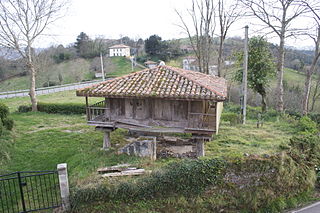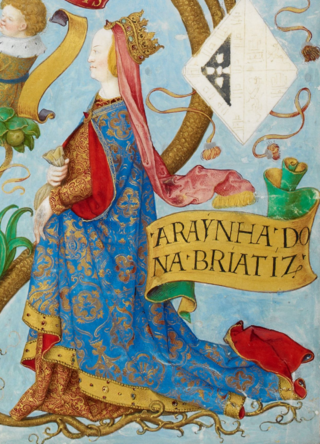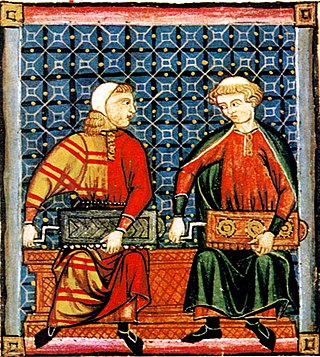
The Cantigas de Santa Maria are 420 poems with musical notation, written in the medieval Galician-Portuguese language during the reign of Alfonso X of Castile El Sabio (1221–1284). Traditionally, they are all attributed to Alfonso, though scholars have since established that the musicians and poets of his court were responsible for most of them, with Alfonso being credited with a few as well.

Alfonso X was King of Castile, León and Galicia from 30 May 1252 until his death in 1284. During the election of 1257, a dissident faction chose him to be king of Germany on 1 April. He renounced his claim to Germany in 1275, and in creating an alliance with the Kingdom of England in 1254, his claim on the Duchy of Gascony as well.

Ramón María del Valle-Inclán y de la Peña was a Spanish dramatist, novelist and member of the Spanish Generation of 98. He is considered perhaps the most noteworthy and certainly the most radical dramatist working to subvert the traditionalism of the Spanish theatrical establishment in the early part of the 20th century. His drama is made all the more important by its influence on later generations of Spanish dramatists. His statue in Madrid therefore receives the homage of the theatrical profession on the National Theatre Day.

Galician-Portuguese, also known as Old Galician-Portuguese or as Old Galician, Old Portuguese, Medieval Portuguese or Medieval Galician when referring to the history of each modern language, was a West Iberian Romance language spoken in the Middle Ages, in the northwest area of the Iberian Peninsula. Alternatively, it can be considered a historical period of the Galician and Portuguese languages.

An hórreo is a typical granary from the northwest of the Iberian Peninsula, built in wood or stone, raised from the ground by pillars ending in flat staddle stones to prevent access by rodents. Ventilation is allowed by the slits in its walls.
A cantiga is a medieval monophonic song, characteristic of the Galician-Portuguese lyric. Over 400 extant cantigas come from the Cantigas de Santa Maria, narrative songs about miracles or hymns in praise of the Holy Virgin. There are near 1700 secular cantigas but music has only survived for a very few: six cantigas de amigo by Martín Codax and seven cantigas de amor by Denis of Portugal.

Beatrice of Castile, an illegitimate daughter of Alfonso X of Castile and his mistress Mayor Guillén de Guzmán, was the second Queen consort of Afonso III of Portugal.

Saint Rudesind was a Galician bishop and abbot. He was also a regional administrator and military leader under his kinsmen, the Kings of León.

Alfonso X of Castile, also known as Alfonso the Wise, ruled from 1252 until 1284. One of Alfonso’s goals for his kingdom was to lift Castile out of the Dark Ages by producing a united, educated, artistic, and religious population. His desire to bring Castile into the mainstream of high civilization led to a boom of cultural activity, including the production and translation of a great deal of literature. The literature produced during his reign was intended to aid him in achieving his goal by giving the common people of Spain access to great intellectual works. Therefore, all of the prose attributed to Alfonso X’s efforts was written in the language of the common people, Castilian, rather than Latin, which was the language of prestige at that time. Although the works are generally attributed to Alfonso X, being a king with other business to deal with he did not himself write most of them. Instead, Alfonso’s role was that of choosing works to be produced and translated, funding the projects, selecting the true authors of the work, overseeing the production, and occasionally contributing personally.
Airas Nunes was a Galician cleric and troubador of the 13th century. He served under a bishop and much later, between 1284 and 1289, was a poet in the court of Sancho IV of Castille.

In the Middle Ages, the Galician-Portuguese lyric, also known as trovadorismo in Portugal and trobadorismo in Galicia, was a lyric poetic school or movement. All told, there are around 1680 texts in the so-called secular lyric or lírica profana. At the time Galician-Portuguese was the language used in nearly all of Iberia for lyric poetry. From this language derives both modern Galician and Portuguese. The school, which was influenced to some extent by the Occitan troubadours, is first documented at the end of the twelfth century and lasted until the middle of the fourteenth, with its zenith coming in the middle of the thirteenth century, centered on the person of Alfonso X, The Wise King. It is the earliest known poetic movement in Galicia or Portugal and represents not only the beginnings of but one of the high points of poetic history in both countries and in Medieval Europe. Modern Galicia has seen a revival movement called neotrobadorismo.
Mayor Guillén de Guzmán (1205–1262) was a member of one of the most aristocratic families in the court of King Ferdinand III of Castile. Her parents were Guillén Pérez de Guzmán and María González Girón, daughter of Gonzalo Rodríguez Girón and his first wife Sancha Rodríguez, and sister of Pedro Rodríguez de Guzmán, Castile's first adelantado and father of Alonso Pérez de Guzmán.

The Castle of San Servando is a medieval castle in Toledo, Spain, near the Tagus River. It was begun as a monastery, occupied first by monks and later by the Knights Templar.

Gonzalo Ruiz Girón was a Spanish nobleman from Palencia. He was Grand Master of the Order of Santiago, and Adelantado of the Kingdom of Murcia. Ruiz was killed at the Battle of Moclín. He was a member of the House of Girón.

The Monastery of Santa María de Huerta is a Cistercian monastery located in Santa María de Huerta, a town of the Spanish Province of Soria, within the autonomous community of Castile and León. The first stone of the building was laid by Alfonso VII of León and Castile in 1179.

The Order of Saint Mary of Spain, also known as the Order of the Star, was a Spanish military order concentrating in naval activity created by Alfonso X of Castile, King of León and Castile in 1270.

Philip of Castile was an Infante of Castile and son of Ferdinand III, King of Castile and León, and his first queen, Beatrice of Swabia. He was Lord of Valdecorneja, and, according to some sources, Knight of the Order of the Temple, in one of those churches, the Church of Santa María la Blanca in Villalcázar de Sirga, he was buried in a coffin adorned with emblems of the Templars.
Ero Fernández was a Galician magnate, count in Lugo, grandfather of St. Rudesind, and ancestor of several noble Galician and Portuguese lineages who married into the highest ranks of the nobility of the kingdoms of León and Castile.
Bernal(do) de Bonaval(le), also known as Bernardo (de) Bonaval, was a 13th-century troubadour in the Kingdom of Galicia who wrote in the Galician-Portuguese language.
Rodrigo González Girón, eldest son of Gonzalo Rodríguez Girón and his first wife, Sancha Rodríguez, was a nobleman from Palencia. After the death of his father in 1231, he was the head of the Girón family.















